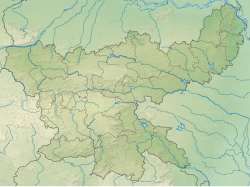| Konar Dam | |
|---|---|
 Konar Dam | |
| Location | Hazaribagh District, Jharkhand, India |
| Coordinates | 23°56′28″N85°46′30″E / 23.94111°N 85.77500°E |
| Opening date | 15 October 1955 |
| Dam and spillways | |
| Impounds | Konar River |
| Height | 48.77 metres (160.0 ft) |
| Length | 4,535 metres (14,879 ft) |
| Reservoir | |
| Surface area | 27.92 sq Km |
| Power Station | |
| Operator | Damodar Valley Corporation |
Konar Dam is the second of the four multi-purpose dams included in the first phase of the Damodar Valley Corporation. It was constructed across the Konar River, a tributary of the Damodar River in Hazaribagh district in the Indian state of Jharkhand and opened in 1955. [1] The place has been developed as a recreational spot. [2]



